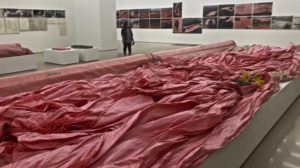Christo and Jeanne-Claude: Surrounded Islands, Pérez Museum, Miami, 2018
When it comes to modern and contemporary art in the 305, Pérez Art Museum Miami (PAMM) has been at the forefront for the last 35 years. Since its inception, PAMM has been committed to presenting art that highlights Miami’s diverse community and encouraging everyone to see art as an incentive for genuine human interaction, communication, and exchange. This is why we are thrilled to present Christo and Jeanne-Claude: Surrounded Islands, Biscayne Bay, Greater Miami, Florida, 1980–83 | A Documentary Exhibition on October 4. This exhibition commemorates the 35th anniversary of Surrounded Islands—an anniversary that also coincides with the founding of PAMM’s predecessor institution, Center for the Fine Arts (CFA).
Surrounded Islands was an endeavor of epic ambition, and the upcoming exhibition will present the entertaining and inspiring history of how the project became a reality. It is a narrative of empowerment, exemplifying the idea that lone individuals are capable of marshaling large civic forces to bring their dreams to fruition—that with determination, willpower, and compelling vision, anything is possible.
PAMM and Surrounded Islands go way back. In 1983, Jan van der Marck, the first Director of CFA, invited Christo and Jeanne-Claude to Miami to consider a local project. Christo and Jeanne-Claude, having been taken by the city’s landscape, proposed a project that evolved into Surrounded Islands.
The project would go on to make a lasting impact on the city’s cultural history, marking the birth of Miami’s international artistic profile while serving as inspiration for untold numbers of people in the South Florida community. The upcoming exhibition at PAMM reinforces the idea that the museum’s evolution has been and continues to be inextricable from the development of Miami as both a city and an artistic hub.
It’s no secret that the project was initially met with some concern from environmental and wildlife activists, residents, and other groups when it was first proposed in 1981-83. However, throughout the preparation, installation, and removal of the project, Christo and Jeanne-Claude and their team worked closely with the US Army Corps of Engineers and state and county regulators in order to ensure its safety to the environment and the local community.

Christo and Jeanne-Claude
For example, the signature pink floating fabric of Surrounded Islands was rigorously engineered to avoid damage to the environment. From November 1982 to April 1983, 6.5 million square feet (603,870 square meters) of pink woven polypropylene fabric were fabricated at Adolff Factory in Germany and sewn at a rented Hialeah factory into 79 patterns to follow the contours of the 11 uninhabited manmade islands. At the Opa Locka Blimp Hangar, the sewn sections were accordion folded to ease the unfurling on the water. Prior to the installation, Christo and Jeanne-Claude and their team cleared the neglected islands of decades of accumulated waste—about 40 tons of garbage, including abandoned home appliances and a boat. Additionally, to ensure the preservation of Biscayne Bay, Christo and Jeanne-Claude donated $100,000 in original art to Miami-Dade County to establish the Biscayne Bay Preservation Fund.

Christo and Jeanne-Claude
Surrounded Islands had a strong impact on Miami, stimulating the growth of the local art community and encouraging the city to recognize the ways in which Miami could become a significant center for contemporary art. In a broader sense, the project had a unifying effect on the city as a whole, prompting residents to come together in celebration of the natural beauty that surrounds them. It brought together thousands of Miami residents to consider the fragility of the Biscayne Bay environment and raised awareness of environmental issues in the greater Miami region. The project exemplifies art’s potential in fostering civic unity, an idea that Miami remains intensely invested in—an idea upon which PAMM is largely premised.
Pérez Art Museum Miami Recalls Pink Islands
The New York Times
By Brett Sokol
-
- MIAMI — It might have been the first time a traffic jam in South Florida ended in smiles. On the afternoon of May 7, 1983, cars began to slow down on the causeways that sail over Biscayne Bay and connect Miami Beach with the mainland. Many motorists stopped altogether, hopping out onto the road for a better look at the surreal sight in the bay: 11 small, uninhabited islands were newly surrounded by 6.5 million square feet of pink woven polypropylene fabric, each looking like a 200-foot-wide, pastel-colored lily pad, shimmering in the tropical sunlight.
